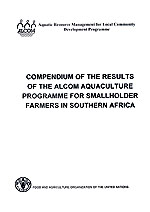
Aquaculture Programme for Smallholder
Farmers in Southern Africa
| ALCOM | GCP/INT/555/SWE |
| Aquatic Resource Management for Local Community Development Programme | |
 | Compendium of the Results from the Alcom Aquaculture Programme for Smallholder Farmers in Southern Africa |
| Table of contents |
by:
Henk van der Mheen
Aquaculturist
Preface
ALCOM is a regional aquatic resource management programme of the FAO (Food and Agriculture Organization of the United Nations), with its head office based in Harare, Zimbabwe. It cover the SADC countries: Angola, Botswana, Lesotho, Malawi, Mozambique, Namibia, South Africa, Swaziland, Tanzania, Zambia and Zimbabwe.
The aim of ALCOM is to assist member countries improve the living standards of rural populations through the practice of improved water resource management. Towards this end, pilot projects are executed in member countries to demonstrate new techniques, technologies or methodologies. Successes achieved, ideas derived, and lessons learned, are applied on a wider scale by member governments.
Abstract
ALCOM started its activities in 1986 with funding from Sweden. Since its inception, the Programme, in view of its wide scope, was not intended for financing by one donor only. The SIDA funding was thought of as the catalytic core contribution.
In the beginning ALCOM focused on the development of methodologies for the sustainable development of smallholder fish farming. Since then, other donors have contributed to the Programme and ALCOM has widened its scope from an aquaculture development programme to an aquatic resource management programme. Activities funded by Sweden, however, have always focused on small-scale fish farming. Funding by SIDA ended in June 1998, and this report summarises the activities carried out under the Swedish part of ALCOM, analyses the results, and comes with recommendations for the continued development of aquaculture in southern Africa.
The designations employed and the presentation of the material in this publication do not imply the expression of any opinion whatsoever on the part of the Food and Agriculture Organization of the United Nations concerning its legal status.
Funding Agency:
SWEDISH INTERNATIONAL DEVELOPMENT AUTHORITY
Executing Agency:
FOOD AND AGRICULTURE ORGANIZATION OF THE UNITED NATIONS
Harare, Zimbabwe, 1999
Hyperlinks to non-FAO Internet sites do not imply any official endorsement of or responsibility for the opinions, ideas, data or products presented at these locations, or guarantee the validity of the information provided. The sole purpose of links to non-FAO sites is to indicate further information available on related topics.
This electronic document has been scanned using optical character recognition (OCR) software. FAO declines all responsibility for any discrepancies that may exist between the present document and its original printed version.
1. INTRODUCTION
1.1 Background
1.2 Objectives
1.3 Target Group
1.4 Implementation
1.5 Research and Development
2. APPROACH
2.1 Extension approach
2.2 Selection of Approach
2.3 Technology Development
3. AQUATIC TECHNOLOGY AND EXTENSION MESSAGE
3.1 Adaptation
3.2 Production system
3.3 Management practices
3.4 Harvesting strategies
3.5 Stocking
3.6 Species selection
4. EXTENSION CHANNELS
4.1 Extension service - Farmer
4.2 Farmer - Farmer
5. PILOT PROJECTS
5.1 Adopted technology
5.1.1 Adoption
5.1.2 Production system
5.1.3 Management practices
5.1.4 Harvesting strategies
5.1.5 Stocking
5.1.6 Economics
5.2 Information channels
5.3 Target group
5.4 Impact
6. ASSESSMENT OF POTENTIAL
6.1 Farmers needs
6.2 Availability of information
6.3 Physical conditions
7. ENVIRONMENTAL ASPECTS
7.1 Impact of aquaculture systems
7.2 Environments for human disease vectors
7.3 Genetic quality of the cultured fish
7.4 Environmental management
8. STRENGTHENING OF INSTITUTIONS
8.1 Information dissemination
8.1.1 Newsletter
8.1.2 Reports
8.1.3 Technical Consultations
8.1.4 Library Services
8.1.5 Impact
9. CONCLUSIONS AND RECOMMENDATIONS
9.1 Regional Level
9.2 National Level